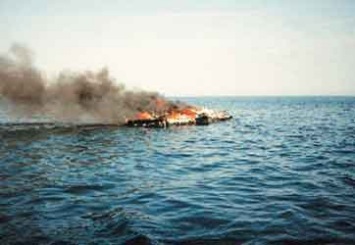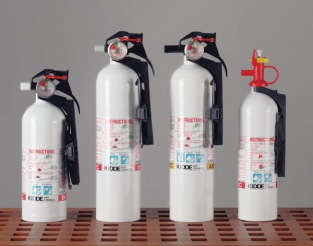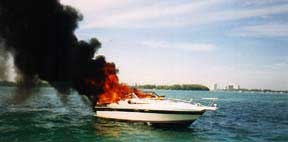Dealing with Fires
Using the Wrong Type of Extinguisher to Fight a Fire is Like Trying to Dig a Hole With a Rake
Fire Extinguishers
The Boat U.S. Foundation for Boating Safety tests of fire extinguishers confirmed that Coast Guard minimum requirements are exactly that: the absolute minimum. For fire extinguishers, they are barely adequate. (For USCG fire extinguisher requirements, see the chart at the bottom of this page.
Carrying only the required minimum is literally "playing with fire." The tests, using a simulated galley fire, revealed that a 2.5-lb. extinguisher in the hands of an inexperienced user lacked the capacity to extinguish the fire-no surprise when you consider that the average discharge time for a 2.5-lb. canister is nine to ten seconds. The National Fire Protection Association (NFPA) has issued extinguisher recommendations that go beyond the Coast Guard's minimum requirements. Not only the number, but the location of your extinguishers is critical-if you can't get to an extinguisher when you need it, it's worthless. You shouldn't have to travel more than half the length of the boat to reach it.
If that's not practical, an alternative is to step up to the next larger extinguisher size. Spend the few extra dollars for a tri-class (ABC) extinguisher instead of settling for the less expensive BC unit. Consider a BC unit for the engine room: it leaves less residue on electrical equipment and machinery, and it costs slightly less. What's the worry?
You might not think you need to worry too much about fire on a boat. After all, you are literally surrounded by water. But fire is a very real threat, not only to your boat, but to you and your passengers. Today's fiberglass/composite boats burn very quickly, and produce large volumes of toxic smoke that is equally as dangerous. Below are a few tips on fire safety from BoatUS Magazine, along with a few claims reports from BoatU.S. Insurance that highlight how quickly events can get out of hand. Knowing what to expect, and what to do are critical if you expect to effectively fight a fire. Each year you need to ensure that your fire extinguishers are in proper working order, and that everyone who boards the boat knows where they are.

Claim #9702081C
The owner and his two friends were nearing the last leg of a long trip from Yorktown, Virginia to Watkins Glen, New York aboard a 46' sport fisherman that he'd bought barely three weeks before. They were making good time across Oneida Lake when one of the crew left the fly bridge to go below. He quickly reappeared on the fly bridge: "We've got a problem," he informed the captain, " smoke!" The captain immediately brought the engines to idle and one of the crew tried very briefly to extinguish the fire. Within a minute or two, he as overwhelmed by fumes and had to abandon the effort. After trying unsuccessfully to send out a Mayday on the VHF, the captain ran to the foredeck, set an anchor, and hailed a passing boat by waving a life jacket. Meanwhile, a volunteer fireman saw the smoke from shore and dispatched a fireboat. By the time the fire was brought under control, the boat was destroyed.
Later investigation determined that the electrical panel was the source of the fire. The captain's urgent Mayday call conveys the danger of all fire outbreaks on boats. Unlike fires ashore, where there are usually several escape routes to safety, there are few places on a burning boat to hide from the heat and noxious fumes. Add to that the anxiety of standing above many gallons of explosive fuel and the choice to sink or swim (literally) becomes even more, well, problematic.
Time is critical with any fire, but when one occurs in the confined spaces of a boat it is imperative that every move made by the crew be the correct move.
BoatU.S. Marine Insurance claim files consistently confirm that a crew that reacts initially with confusion and indecision is likely to panic as the fire spreads.
Success and failure depends on understanding the fundamentals of fire classification, and providing the most efficient fire extinguishers in the locations where they are most likely be needed.
The Fundamentals
Learning Your ABCs of Fire Classification
Not all fires should be treated alike. The source and location of a fire will determine which extinguishing agent should be used for maximum effect. Many people learn at home, for example, that throwing water on a stove-top grease fire (Class B) will cause a violent spattering reaction and spread the burning grease elsewhere. Matching the agent to the fire begins with an understanding of how fires are classified:
- Class A fires consist of all combustible solid materials, such as paper, wood, cloth, rubber, and many plastics including the fiberglass reinforced plastic used for decks and hulls.
- Class B fires consist of all flammable liquids, including stove alcohol, grease, gasoline, diesel, kerosene, oil, oil based paint, teak oil, paint thinners, acetone, varnishes, and flammable gases or fumes.
- Class C fires consist of energized electrical equipment. Class C fires are identified for their potential to electrocute or shock personnel if conducting water-base extinguishing agents are applied. Turning off the electricity will change the status of a Class C fire to a Class A and/or B fire.
- Note that Class A, B, and C categories are not subdivided any further, so it may be easier to think of them as (A) solids, (B) liquids, and (C) electrical fires; there's no need, for example, to waste time distinguishing between alcohol or kerosene when your stove's on fire.
All fire extinguishers are rated according to the extinguishing agent's effectiveness in controlling one or more classes of fire. For example, ABC-rated extinguishers, commonly called multi-purpose or tri-class extinguishers, are capable of fighting all three classes of fire. Numbers preceding the letters (on portable units only) indicate an agent's relative effectiveness in extinguishing that particular class of fire. For instance, a 10 BC dry chemical extinguisher is twice as effective in putting out a fire as a 5 BC unit. Multi-purpose 1A-10 BC dry chemical extinguishers are becoming more popular as an alternative to the common 10 BC extinguishers because of the additional Class A rating, especially since the additional cost is minimal (less than $5).
In general, dry chemical extinguishers, which use a chemical powder to smoother the source of the fire, are the favored choice in the boat's cabin. Not only is a dry chemical extinguisher more effective, it is easier for an inexperienced user to direct the discharge plume to the base of the flame from a safe distance.
Conversely, extinguishers with gaseous agents ( CO2, Halon, and Halon replacements FE-241 and FM-200), which react with the surrounding oxygen, aren't as effective in a cabin because the gases are often dissipated before the fire is extinguished.
The ABC units have the drawback of often ruining equipment, but because the priority is on safety and the overall effectiveness of the extinguishing agent, the American Boat & Yacht Council (ABYC) recommends that ABC multi-purpose extinguishers be used in most instances on boats under 65'. The ABC extinguishers not only reduces any confusion about what to use and where (saving time), but also covers the possibility that, for example, any Class B fire that spreads from the stove to the curtains (Class A) can be fought with the same extinguisher.

United States Coast Guard Minimum Equipment Requirements
Coast Guard minimum equipment requirements vary with the size of the boat, type of propulsion, whether operated at night or in periods of reduced visibility, and in some cases, the body of water on which it is used. Boats carrying passengers for hire have additional equipment requirements.
- All fire extinguishers must be Coast Guard Approved
- Fire extinguishers must be in serviceable condition
- All fire extinguishers must be READILY AVAILABLE for immediate use
- Boats less than 26 feet in length: At least one 2 pound hand-portable extinguisher (assuming no fixed-fire extinguishing system is installed). When an approved fire extinguishing system is installed in machinery spaces, no extinguisher is required. If construction of the boat does not permit the entrapment of explosive or flammable gases or vapors, no fire extinguisher is required. (Boat must be under 26 feet long and outboard powered)
- Boats 26 feet to less than 40 feet in length: At least two 2 pound portables, OR at least one 2.5 pound extinguisher. When an approved fire extinguisher is installed, one less 2-pound extinguisher is required
- Boats 40 feet to not more than 65 feet in length: At least three 2 pound portables, or at least one 2 pound and one 2.5 pound extinguisher. When an approved fixed-fire extinguisher is installed, one less 2 pounder is required
| MARINE FIRE EXTINGUISHER CLASSIFICATION | ||||
|---|---|---|---|---|
| Classes | Foam (Gals) | CO2 (Lbs.) | Dry Chem (Lbs.) | Halon |
| B-1 | 1.25 | 4 | 5 | 2.5 |
| B-2 | 2.5 | 15 | 10 | 10 |
For more details on how many and what types of equipment you must have aboard your boat, request a copy of the free brochure, "Federal Requirements for Recreational Boats", from your BoatU.S. Marine Center, the BoatU.S. Foundation, or from the Coast Guard Consumer Hotline, 800-368-5647.
Fighting Fires
Fight a Fire Yourself If and Only If:
- It's small and confined to the immediate area where it started. Generally, if you don't get to it within two minutes, you're too late.
- You have a way out and can fight with your back to the exit.
- Your extinguisher is rated for the class of fire at hand. (If you bought ABC units, you don't have to worry about this.) Only Class A fires can be extinguished with water.
- You are confident that you can operate your extinguisher effectively: Aim the nozzle at the base of the fire. Hold the unit upright. Sweep from side to side at the base, or use a series of short blasts aimed at the base. Check for glowing or smoldering embers and repeat the procedure if "flashback" occurs.
- If you have the slightest doubt about whether you can contain the fire, don't even try. Your first concern is the safety of the people aboard. Notify someone immediately of your situation and location before the fire burns through the battery cables or forces you off the boat.
Burning fiberglass is extremely hot and gives off noxious fumes. If fiberglass is burning, get off the boat immediately!
Portable Fire Extinguisher Maintenance:
- Inspect once a month, more often if exposed to weather.
- Have the unit weighed annually to verify it's fully charged. Gauges fail often enough that they cannot always be relied on. Twice a year, remove unit from bracket, turn upside down and shake to loosen any dry chemical compacted at the bottom.
- Recharge or replace after any use. Recharges run $15-25. Inexpensive units can be replaced for about the same amount.
- Never check a unit by partially discharging it. Remaining pressure in canister can leak out over time.
- Have a full maintenance check annually by a qualified technician; see the Yellow Pages under "Fire Extinguishers." A more economical method: weigh the unit your- self every year, and replace it every few years.
A Subtle, but Costly, Distinction
A 42' powerboat was cruising offshore when a crew member reported a strange smell coming from the engine compartment. The owner grabbed a dry chemical extinguisher from the galley on his way to the enclosed compartment, opened the access door, and was immediately driven back by smoke. He tried to direct the stream of dry chemical inside the compartment, but he could not see beyond the smoke to locate the source of the fire. By then the fumes had also engulfed the main saloon and he was driven back. From the cockpit he saw flames coming out of the engine compartment's starboard ventilation ducts, so he directed another dry chemical extinguisher into the duct openings; the fire died momentarily but quickly resumed and grew rapidly. It soon became apparent that the vessel would have to be abandoned. It burned to the waterline (claim 9708770C).
The same dry chemicals that are so effective in a boat's cabin, aren't much use when a fire breaks out in the engine compartment. The reason has to do with how the two types of fires are fought.
Accounts of engine fires typically began with a warning - a burning smell, a loss of engine power, or even smoke trailing after the boat. If someone then opened the engine hatch to check out the trouble, he or she was usually overwhelmed immediately by flames and smoke.

Fires need two things: fuel and oxygen. Opening an engine compartment hatch to look for a fire is like throwing gasoline on hot coals; it fans the fire with a rush of fresh oxygen.
The solution is to leave the hatch closed and fight the fire either with a fixed extinguisher in the engine compartment or with a portable extinguisher discharged through a fire port " (a small opening into the engine compartment) on deck, which is why dry chemical extinguishers of any class are inappropriate. Blindly spraying a chemical extinguisher through a fire port does little or nothing to stop an engine fire because the chemical isn't being directed toward the base of the flames. A gaseous extinguisher, on the other hand, extinguished the fire by effecting the oxygen supply. The same extinguisher that wasn't effective in the wide-open spaces of a boat's cabin will be much more effective in a cramped engine compartment.
For this reason, among others, the ABYC recommends that either a portable gaseous extinguisher be provided near (outside) the engine compartment or a fixed gaseous extinguishers be used inside the engine compartment. In the event of a fire, either option eliminates the need to open the hatch.
Fixed Systems in the Engine Room
Overall, the most efficient fire protection system is the safest. The majority of fires begin in the engine compartment for numerous reasons:
- Constant pounding and vibration loosens wiring terminals and causes chafe, engine exhausts fail, water pumps fail, fuel leaks--the list goes on.
- An automatic system, activated by a rise in temperature, can discharge and extinguish a fire long before any crew can detect a fire and react with a portable extinguisher, which is even more relevant if you sometimes cruise short handed.
- The automatic system kills the fire earlier and minimizes damage. And since Halon and its replacements will not damage internal engine parts, it is often possible, after locating and correcting the problem, to restart the engine(s) after a fire and return to port.
- Fire extinguishers are typically the last line of defense when a fire suddenly appears. The first line of defense is knowing how to prevent fires before they occur.
Restrictions on Halon
For many years, Halon was recognized as the most effective fire fighting agent available. It was quick to extinguish all classes of fires and was particularly safe and effective for use near expensive electronic equipment because it left no residual damage. And, it was safe for both occupied and unoccupied spaces. It was then determined that Halon posed a significant threat to the environment by contributing to the depletion of the ozone layer, and as of January 1, 1994, no new Halon could be made in the U.S. However, recycled or previously made Halon is still available for purchase, so you don't have to dispose of an old Halon unit. It only poses a danger to the ozone if it is used or develops a leak. As long as your unit is in good condition and not leaking, it's safe to keep on board.
The Halon Alternatives-FE-241 and FM-200
With the phase-out of Halon 1301, the search for a replacement resulted in the development of a number of "clean" fire suppression agents. Both FE-241 and FM-200 have been shown to be effective, safe for people and equipment, and environmentally friendly. Although both agents do pose some threat to the environment, it is considered to be substantially less than that of Halon. Their characteristically rapid extinguishing performance is considered by most to mitigate the detrimental effects of fire. Both agents' relatively short atmospheric lifetime (somewhere between 7-42 years) assure minimal direct contribution to global warming. When choosing which system is best for you, keep in mind that FM-200 is considered to be safe for use in occupied spaces, whereas, FE-241 is not as safe, but is significantly less expensive. Both require more agent by weight than Halon 1301 did, so your storage requirements for the extinguishers may increase. Both are Factory Mutual (FM) and USCG-approved.

